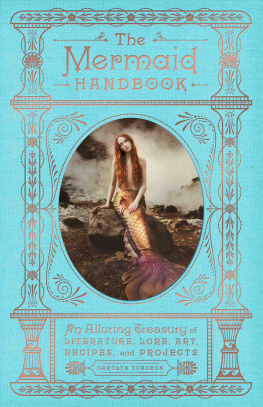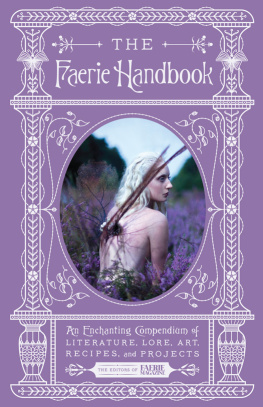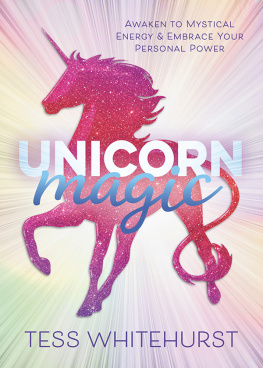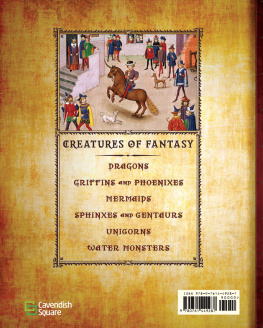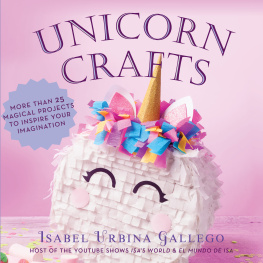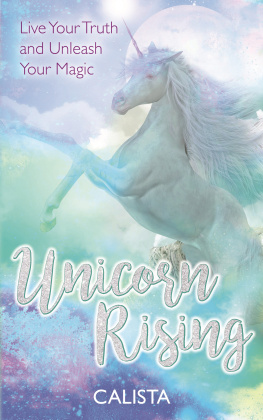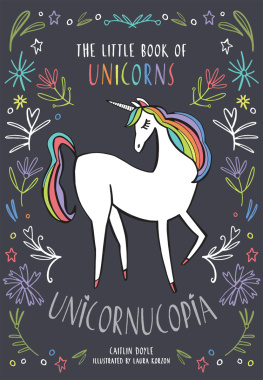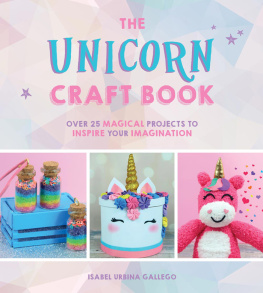Unicorn Vanessa Walton wearing a horn by Jessica Antico Brasz. Photograph by Elizabeth Elder.

Annie Stegg, Wildest Grace, 2016.
Stegg, Annie
T HIS BOOK IS ABOUT A CREATURE SO WILD AND dazzling, so otherworldly yet so of this world in its most enchanting form, that you might want to bathe in purified water infused with rosemary and lavender before handling its pristine pages. Consider unplugging from your electronic appendages, and possibly even retreating from humankind altogether, before reading further. In our modern age, the unicorn may wink out from glittery pink and purple kitty cafs, toy stores, cartoons, and frothy rainbow drinksan icon of kitsch and fizzbut actual unicorns are so fantastically pure that the human eye cannot even recognize them.
Its common knowledge that when the unicorn leaves the enchanted wood to explore the world beyond, it appears like a regular horse to humans, so you might want to look carefully at the next hooved creature or two you come across, just to see if you can detect some extra sparkle. In Peter S. Beagles tome The Last Unicorn (1968), when people gaze upon a unicorn they see only an old white nag, which begs the question: How many normal-looking creatures, animals and humans alike, are actually unicorns?
Even more than the mermaid, with her come-hither sexuality, or fairies, with their mischievous penchant for whisking humans off to fairyland, the unicorn is unadulterated glamour, divinity on Earth, the purest heart of the forestand untouchable. When unicorns deign to hang out with humans at all, they prefer to pass the time with virginal ladiesand, if possible, ones with long, lustrous hair who dont mind hanging out by streams with clear waters that glisten like diamonds or petting them and protecting them from the occasional wild-eyed hunter. Sadly, hunters have taken advantage of the unicorns fondness for napping upon virginal laps to capture and even kill these stunning beasts.
What is a unicorn, pray tell? Proud, strong, swift, majestic, and magnificently handsome, the unicorn is a magical male animal whose name derives from the Latin words unus (one) and cornu (horn). The unicorns ferocity makes him a formidable foe, and he is said to be the opponent of both the elephant and the liontwo of the most powerful animals on Earth. The unicorn lives alone, deep in an enchanted forest, and is rarely seen by humans. Those who have the good fortune of spying one are lucky indeed; they are also most likely virgins or enchanted beings, too. The only way to tame or capture a unicorn, in fact, is to entice him with his ultimate weakness: a young woman who has never known a man (or woman), as the unicorn is downright docile in a virgins hands. He will approach her gently, put his head in her lap, and even fall asleep.
In antiquity, there was no one single vision of what a unicorn looked like, but writers like the Greek physician Ctesias (400 BCE), in his book Indica (On India), and Aristotle, in Historia animalium (The History of Animals) (350 BCE), described one-horned animals that looked like bulls, antelopes, oryx, and dozens of other things. (For more on Ctesias and Aristotle, see .)
In Europe during medieval times, the unicorns regal bearing was considered not only aristocratic but also the embodiment of chivalric ideals, making him an essential companion for every knight. Artists of the day portrayed the unicorn as white, with an elegant and refined frame, like a fine horse yet smaller, more the size of a goat or a sheep. His mane and face are adorned with long, thick, curly clusters of silky hair. His hooves are cloven, and his tail is tufted like a lions. His single horn is a long spiral that extends straight up from his forehead and is most often white, although in some medieval texts and illustrations it was described as gold or red, or black and whiteor various combinations of these colors. In one of the most famous pieces of unicorn art, Raphaels , the virginal lady cradles what appears to be a horned baby goat.
When we think of a unicorn now, the picture that most commonly comes to mind is that of a large elegant white horse with a long spiral horn on its head or perhaps, something like the white or rainbow-colored stuffed animals sparkling with glitter that populate the shelves of toy stores. But, like so many of our modern images, these visions are inspired by advertising and the movies. Its impossible to cast real unicorns, of course, as they are not only wild, making them impossible to please on set, but also so rare that their presence commands an extraordinary fee and share of the profits. This is why contemporary photographers, artists, film and television directors, and advertising creatives use horses and simply add the horn. And if employing a horse isnt in the budget, they use a goat or lamb, which fools most of the people most of the time.
But forget all that. Imagine yourself standing next to a glittering brook flowing through a deep forest glade. Here, flowering vines drape over everything like starlets on old-time chaise lounges. Branches twist, covered in moss. Sunlight spills through the leaves, bright green and shaped like hearts, to decorate the forest floor. Birds sing and foxes dart and butterflies flit about showing off the latest fashions. The brook burbles and shimmering fish rise to the surface of the water, which is so clear you can see the grassy bottom. Around you, imagine every kind of flower blooming all at once, the clean perfumed air, the bees buzzing from bulb to bulb, the riot of colors and scents. Trace your fingers upon the tree bark, step barefoot on the petals that have fallen and marked out your path. Breathe in as you enter the deep heart of the forest.
This is where youll find a real unicorn, most likely loping gracefully about or lying in a bed of moss snacking on sweet forest berries, its head gently laid upon a virgins lap.
Come. Lets go say hello.
C AROLYN T URGEON

A glamorous, unicorn-loving maiden (Sophia Elam), with tresses by Arda Wigs, styled and shot by Firefly Path.
Conway, JoEllen Elam

Jacob Bouttats, Orpheus Charming the Animals, c. 1675.
Rafael Valls Gallery, London, UK/Bridgeman Images
The Unicorn Horn


